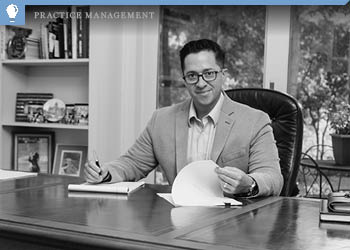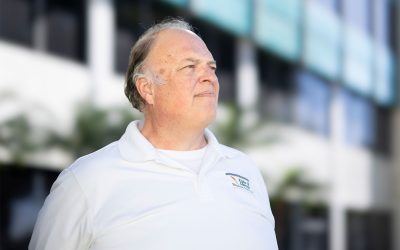Walking the walk as a holistic financial planner
Walking the walk as a holistic financial planner

For Harmon Kong, holistic financial planning is the preferred way to help clients live the kind of life they want—both financially and emotionally.
Kong, CFP, AIF, and co-founder of Apriem Advisors based in Irvine, California, shares his journey to becoming a holistic planner in his new book, “Values Over Valuables.”
In the book’s introduction, Kong writes,
He adds,
“No amount of money can fix a family when the fundamentals are failing. Such dysfunction can lead to everyone suing everyone—children fighting parents, sibling fighting sibling. The money only adds fuel to the fire, and it all just goes up in a brighter blaze. …
“To do business the way I wanted, I resolved to launch my own independent practice focusing on families and their overall well-being. I knew that developing meaningful relationships should not be optional. It should be everything.
“In addition, we resolved to serve our clients ‘to the highest degree’—which is the Latin-based meaning of Apriem. We would do so by working with them one-on-one, emphasizing the importance of giving purpose to their money and instilling their values in the next generation. That would be our mission. That would be the Apriem Way. …”
The rise of holistic financial planning is undeniable. Connor Sung, director of eMoney’s Financial Planning Group, highlights this in his article, “The State of Holistic Financial Planning: The Effort and the Result.”
A recent survey by eMoney asked advisors if they were holistic planners, and 92% said yes. But when the term was subsequently defined as those who offer 10 or more services to their clients, review plans with clients at least once per year, are comfortable with in-depth client conversations, and are not “extremely uncomfortable” with any personal topic of discussion, only 46% of the survey respondents said yes.
Still, nearly all of the respondents said that they believe holistic planning is growing, with 53% saying there will be moderate to extreme growth.
Sung writes,
“Holistic planning is a trend that’s here to stay. The vast majority of financial professionals believe in its growth over the next five years and those who are already offering holistic planning are seeing superior results.
“Clients too stand to benefit when their financial planner takes a comprehensive view of their life circumstances—something newer generations are increasingly expecting from a financial professional.”
Holistic planners report specific financial-planning successes, including the following, at far higher rates than other planners:
- Engaging clients in ongoing, candid discussions about money-management behaviors
- Empowering clients to develop better relationships with money
- Helping clients reduce financial anxiety and achieve greater peace of mind
- Building strong relationships with clients in a scalable way
- Transforming financial planning into a passion and personal strength
- Keeping clients highly engaged with their plans and motivated to reach their goals
- Offering clients consistent financial behavioral coaching
Source: eMoney
In an interview with Proactive Advisor Magazine, Kong shares his best practices for holistic financial planning and the importance of shared family values.
How do you employ your holistic approach in initial client interviews and onboarding, and what do those conversations look like?
“As financial advisors, we try to understand as much as we can about our clients’ overall financial circumstances, which requires learning everything we can about what impacts them financially. Along those lines, we try to understand some of the more qualitative issues that they face.
“Most people view financial independence through the lens of financial security—’Once I get there, then I’m free because I can do whatever I want. I don’t have to work.’ A lot of clients come to us thinking that we’re going to help them with this, and we do. But we also ask deeper questions like, ‘OK, once you’re there, then what does your life look like?’
“Or sometimes we have clients that are already financially secure. For these clients, we might ask, ‘What keeps you up at night?’ or ‘What if you double your net worth—what does life look like?’ These types of questions allow you to learn a little more about the client.
“These conversations are often about lifestyle, not just finances, and we often ask nontraditional questions they might not expect from their financial advisor. One very profound question we ask is, ‘What do you worry about?’ The answers often come down to generational challenges, and I want to understand how to best approach that.”
Do you discuss the importance of regular family meetings during the onboarding process? And if not, when do you suggest these family meetings?
“I’m a big believer that family meetings should happen regularly, and I discuss them with clients early on. Some clients are ready to go, while others need a little bit of help figuring out what that would look like. We try to provide guidance on how to hold a healthy family meeting where everyone has a voice—and how to deal with some anticipated dysfunction.
“Family meetings foster unity around shared values and ambitions—and just a greater understanding for each other. The deep discussions that occur during these meetings can often help alleviate client concerns about the next generation’s readiness to assume responsibility—both in terms of financial stewardship and in keeping family relationships strong. Children of the client may already be parents or will be in the future. Family meetings can serve as a model example of how best to talk about the things that matter most.”
Do you encourage clients and their families to complete the “Discovering My Values” and “Family Vision and Mission Statements” worksheets from your book during these initial discussions?
“These exercises can be completed whenever it makes sense for the client. I might suggest them early on if I sense they’re interested, but others may prefer to focus on, say, their estate plan or retirement plan first.
“We’ll start by addressing their agenda and priorities, and then we may gradually introduce other considerations by asking a question like, ‘What are your core values as a family?’ Some clients already know their values, but they haven’t necessarily written them down or spoken them aloud.
“We’re not forcing this by saying, ‘Unless you do this, you can’t be a client.’ Some clients are more motivated to do it right away, while for others, it takes time.”
“In many families, sadly, so much is left unsaid. Money can become such a touchy subject that people hesitate to talk about it, even with their closest loved ones. It’s time to have those conversations. Families need to engage in discussions that go beyond tweets, texts, or social media posts—real conversations about what matters most. Completing these worksheets can have tremendous value in facilitating meaningful family conversations.”
How do you manage couples with opposing investment philosophies—one being conservative and afraid of market losses, and the other more aggressive and willing to ride out losses for longer-term gains?
“Oftentimes, financial advisors ask potential clients to complete a risk profile form. But for a married couple, are you giving them one questionnaire or two? If it’s just one, it might take them a long time to fill out—especially if they can’t agree on their risk profile or how they see themselves as investors.
“Is it OK to have two separate strategies or accounts? I would say yes if their risk profiles are very different. For example, if you push the conservative spouse to be more aggressive, they’re likely to worry and lose sleep. That can strain the marriage, so it’s not worth it. The key is to meet them where they are without compromising their goals.”
What do you discuss in routine checkup meetings, and how do you encourage clients to share updates about family conversations around money and values?
“In these meetings, we ask open-ended questions. As the relationship matures, the conversations often shift from financial topics to lifestyle and family discussions. I think that’s where some financial advisors say it feels a bit like being a therapist because we have a window into our client’s life, as money and finance can be very sensitive and personal topics.
“What I love most about our work is that we can help clients understand three dimensions of financial freedom: security, peace of mind, and purpose. If you can address those, you can have some meaningful conversations.”
What is your overall investment philosophy for client portfolios? Does risk management play a large role?
“We have a traditional asset allocation strategy, trying to determine the appropriate mix of equities, fixed income, and alternatives based on the client’s objectives, goals, and preferences of what’s available in the marketplace.
“We use both passive and active strategies. For beta exposure, we typically use exchange-traded funds to maintain market correlation. To capture some alpha, we’re open to including individual stocks and bonds outside of broad-based exchange-traded funds for our client portfolios—though this depends on the client’s preference, as not every client is comfortable owning an individual company.
“We also work with third-party investment managers, particularly for beta and correlation plays. Additionally, we use active fixed-income managers because they can scale it pretty well for a very low cost to us and the client.”
How do you guide clients who have lived through significant market downturns, like those we saw in the early 2000s and during 2008-2009?
“We start by asking them how they responded during those periods. How did they feel? What did they do? Understanding their past reactions helps us anticipate how they might respond in the future.
“We also conduct Monte Carlo stress testing to simulate how their portfolio would perform under various market conditions, running 1,000 scenarios based on their asset allocation strategy or risk profile strategy. Would they be OK if the market were to have a drawdown of 30%, 40%, or 50%? ‘Are you going to call us and tell us to sell? Because here are the consequences if you do.’
“That’s how I think we can best help our clients—coaching and educating them on the process.”
How do you approach conversations when clients face personal or family challenges, such as estrangement, divorce, or disputes over money or inheritance?
“These situations are more common than people realize. My first step is to avoid any sense of judgment or assignment of blame. I start from a position of empathy, saying something like, ‘I feel for you,’ and then try to get to the root cause.
“We carry things from our past into our present conversation, and that isn’t always healthy. So how do you unwind that? It’s not easy, and sometimes advisors need to involve other professionals. We might see what I call the symptoms, but we don’t always know the cause.
“What I like to do if I believe clients are open to it, is to encourage family meetings with an objective person in the room. Sometimes it’s easier for someone else to mediate because clients are too invested in the situation. I let them know that I’m always available to assist in these situations because I want to understand the root cause of what’s happening. Money can become a divider and a source of harm—and nobody wants that.”
What should advisors consider when deciding to use a similar holistic approach to serving clients?
“If you know your client’s core values, I honestly believe that you can better serve your client. Knowing their financial balance sheet, income, assets, and portfolio is just the foundation for preparing a financial plan. You want to get underneath that. To do that, you need to discover what they really, truly care about and what drives them.
“I believe everyone looks at life a certain way, makes decisions a certain way, behaves a certain way—and it’s based on their core values, whether they’re spoken or unspoken, written or not. Helping clients identify and articulate their values makes it easier for them to embrace those values, and it enables us as advisors to connect on a deeper level. That, for me, is holistic financial planning.”
The opinions expressed in this article are those of the author and the sources cited and do not necessarily represent the views of Proactive Advisor Magazine. This material is presented for educational purposes only.
CFP is a registered trademark of the Certified Financial Planner Board of Standards Inc. (CFP Board). AIF is a registered trademarks of Fi360, a Broadridge Company.
RECENT POSTS









